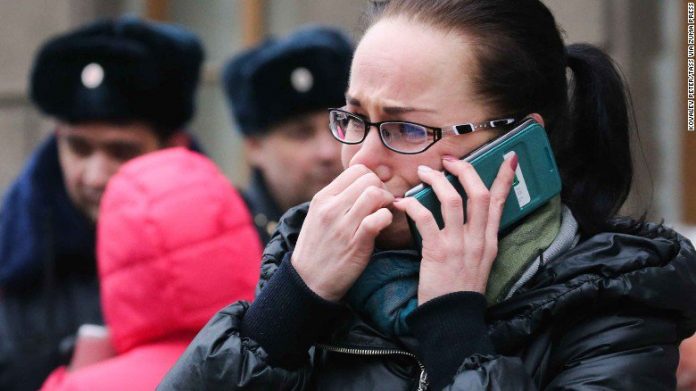
ST. PETERSBURG, Russia – A large explosion blew a hole in the side of train as it traveled between two central St. Petersburg metro stations Monday, killing at least 11 people and sending panicked commuters diving for cover in what Russian authorities were investigating as a possible terrorist attack.
At least two suspects were sought, officials said, but they gave no immediate details on identities or any suspected affiliation in the blast, which rocked the heart of Russia’s second largest city and prompted calls for increased security measures in the country’s public spaces.
Even as authorities probed the scene of the explosion – which left more than 30 people injured – a separate shrapnel-filled explosive device was found and disarmed at another subway station. The discovery further focused the probe on a possible coordinated plot, and Russia’s Investigative Committee said it was looking into the incident as a possible terrorist attack.
Security forces fanned out on extra patrols as police helicopters crisscrossed overhead in one of the city’s most celebrated, and tourist-visited, neighborhoods. The area around the Sennaya Ploshchad station is near some of the most famous sights of St. Petersburg, and was the setting of Fyodor Dostoevsky’s novel “Crime and Punishment.”
Shortly after the blast, the entire St. Petersburg subway system was shut down as a precaution, and security was boosted around the city, where Russian President Vladimir Putin was holding talks with Belarusan leader Alexander Lukashenko.
Outside the city’s main train station, more than 100 stranded passengers lined up for rides – not just from city transport but also from friendly drivers in a ride-sharing program arranged over social networks.
Andrei Przhezdomsky, spokesman for the National Anti-Terrorism Committee, said the blast was caused by “an unidentified explosive device” in one of the cars as the train traveled from Sennaya Ploshchad station, one of the main interchanges of the city’s subway system, at about 2:40 p.m.
The operator was able to get the train to the next station, where authorities reached the victims, Przhezdomsky said in remarks broadcast on state television. Amateur video shared on social media showed a large, jagged blast hole in the side of one car.
The state-run Rossiya-24 television station broadcast a brief interview with two men, one with blood on his forehead, who described climbing out a window of the train.
The St. Petersburg office of the Federal Security Service said in a statement that an “unexploded device” filled with shrapnel was found at the Ploshchad Vosstaniya metro station. “The device was defused by a bomb squad. No one was injured,” the statement said.
The station is located at the city’s main train station and, like Sennaya Ploshchad, is one of the central interchanges in the city subway system.
Russia’s health minister, Veronika Skvortsova, said seven people died at the scene, one died en route to the hospital and two more while undergoing treatment. She said six people remained in serious condition, raising the possibility that the death toll could rise. Authorities late Monday said an 11th person had died.
“Law enforcement agencies and the special services are working on it, and they will do everything to find out the causes of the incident and make a full assessment of what happened,” Putin said in televised remarks at the meeting with Lukashenko. “Naturally, we always probe all theories, both domestic and criminal ones, primarily actions of a terrorist nature.”
Viktor Ozerov, a member of the defense and security committee of the upper house of the Russian parliament, told the Interfax news agency that the attack had “all the characteristics of a terrorist attack.” Other legislators called for increased security measures.
Although there were no official statements about the direction of the investigation, Rossiya-24 reported that authorities have video of a possible suspect entering the Sennaya Ploshchad station. Social media were circulating what some Russian agencies called a screen grab of the picture, but it was unclear whether the image was an official one.
The picture shows a man with a long beard, wearing black clothing and a kufi cap – all indicative of observers of strict Sunni Islam in the restive North Caucasus of southern Russia.
Islamist militants from the North Caucasus have been blamed in more than a dozen major terrorist attacks in Russia since the country fought two civil wars in Chechnya. Russia still faces a simmering insurgency in the neighboring Dagestan province, and in March, six Russian soldiers and six militants were killed in a shootout in Chechnya.
The city of St. Petersburg announced three days of mourning beginning Tuesday. The U.S. Embassy in Moscow joined other countries in expressing condolences.
In Washington, President Donald Trump called the incident a “terrible thing.” France’s interior minister, Matthias Fekl, said security would be reinforced around public transit sites in the Paris region.
In Moscow, dozens of young people gathered outside the Kremlin to lay flowers at a World War II memorial to the city of Leningrad – St. Petersburg’s name at the time.
All St. Petersburg and Moscow subway stations have metal detectors and baggage scanners, though staff have been lax about what and who gets searched.
Officers only sporadically put larger packages through a baggage scanner and permit items such as concealed cameras and tripods to pass through without additional checks.
(c) 2017, The Washington Post · Andrew Roth, David Filipov

